Opinion
Infinity Gems and the Art Gallery: What Ambitious Artists Can Learn From Marvel’s Cinematic Universe Adventure
More than you might think!
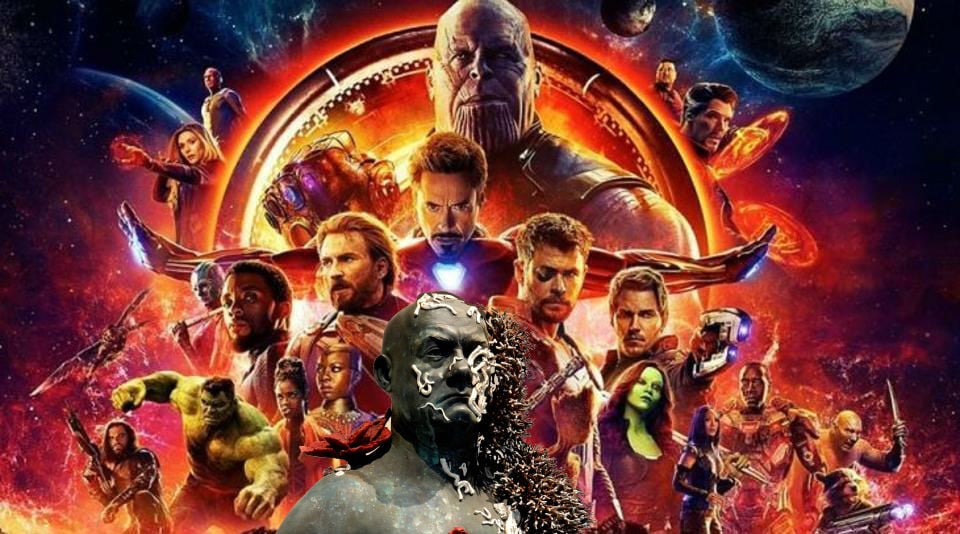
More than you might think!

Ben Davis

Don’t laugh: I’ve been asking myself what this week’s big release of Marvel’s The Avengers: Infinity War might mean for art.
I know the idea feels pretty crass to a good portion of the art-reading audience. Irradiated by the gamma rays of Disney money and marketing, superheroes have become an attention-hogging cultural juggernaut. If anything, people go into their art studio or to the museum to escape that noise. (Or some people do; I don’t personally feel like I have to choose.)
If nothing else, though, the superhero craze that has gathered momentum since the turn of the millennium—and in particular in the decade since the financial crisis (and the release of Iron Man in 2008)—is a cultural landmark, what the Golden Age of the cowboy movie was to the 1950s. And on the one hand, you might say that the heroics of Shane or High Noon don’t have a heck of a lot to do with Abstract Expressionism. But you can also say that the theme of the rugged individual forging a uniquely American mythology does have some kind of if-you-squint resonance….
Recently, the photography critic Danielle Jackson had a great article arguing that contemporary photojournalists are still working with ideas of audience inherited from an earlier time. She makes the case that the field has yet to wrestle with how the present-day media environment’s splintering world of attention affects the consciousness-raising mission that the genre is based on. For art, I have a similar conversation in mind, about trying to figure out the dynamics of how things catch fire in the cultural imagination now.
And, goofy as it may sound, the Avengers case is particularly interesting.
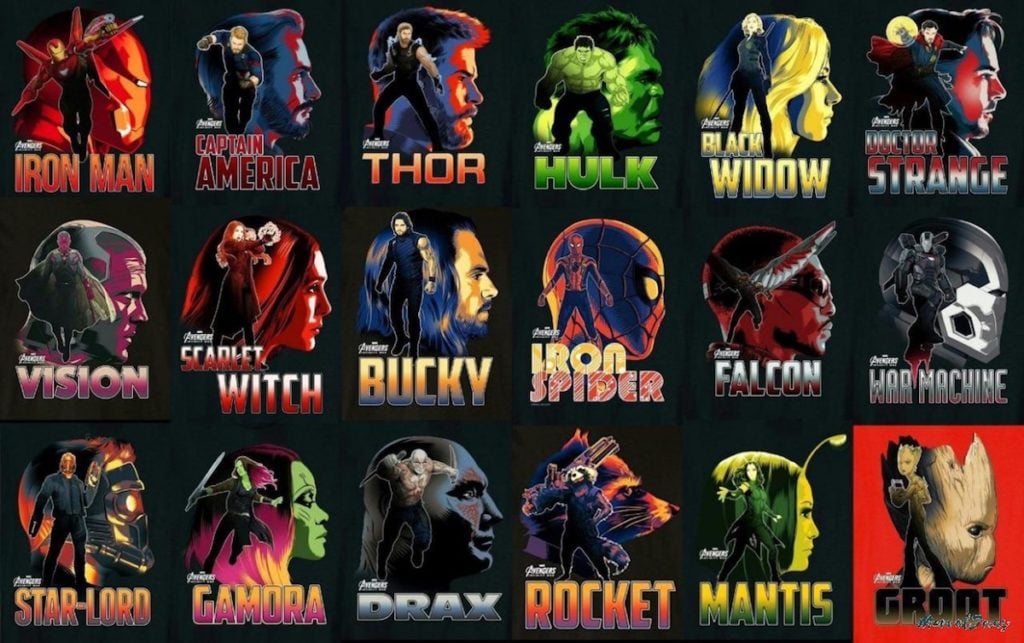
The Avengers: Infinity Wars character promo.
Stepping back from the hype, you really do have to appreciate what a weird idea this is for a successful film series. It’s not just a franchise, but a franchise of franchises, blending the disjointed mythologies of various heroes together into a kind of spumoni entertainment experience.
Forged over the course of 10 years and 18 movies, the Marvel Cinematic Universe—MCU in fan parlance—shouldn’t work, but it does, and it is the envy of every other contender for your entertainment dollar. It has hit a nerve that so far no other movie studio has replicated—not Warner Brothers’s now pathetically deflated DC Extended Universe, and certainly not Paramount’s failed Dark Universe, an attempt to create a monster movie equivalent that went down in a cloud of bats last year with The Mummy.
And part of this isn’t just the fact that the overlords at Marvel/Disney got lucky, or even that they have done an uncommonly good job of navigating the pressures of machine filmmaking, recreating old Hollywood’s “genius of the system” in spandex. It’s that the separate-but-connected, mutually interpenetrated nature of these films gets something important about how culture works now. I keep coming back to a particular observation about the original 2012 Avengers film, from a YouTube video essay by a favorite film critic, MovieBob:
The world of movie culture, particularly the mainstream blockbuster movie culture, is a different place now, with the barriers between film, television, internet, etc. broken almost completely away. And while other films try to resist or restrict that new world, Marvel embraces it. And while [the films] stand up fine on their own, the real extended experience of the Cinematic Universe movies is to see the films in theaters, rewatch the other films at home, look up the nuggets and Easter Eggs that maybe you didn’t quite grasp online, and share theories about ongoing story threads and continuity via social media. Love it or hate it, this is big-ticket movie going in the 21st century, and Marvel has blazed the trail.
You’d think that at the highest level of blockbuster entertainment, you should really be able to buy an audience’s attention with state-of-the-art special effects and bankable actors. But that’s the thing about the present: You can’t. You need something more.
Even these giant films have to compete at the level of being 360-degree-wraparound, fully inhabited universes, linking pre-invested, larger-than-life pop mythologies with an endlessly refreshing, ultra-granular online conversation. They are not discrete one-off experiences. Each discrete experience is a node in a larger chain.
Now, by definition, such expansive cultural worlds are hard to generate, because it’s not just anything that can animate people’s interests like that. So is there an art equivalent, or an artist trying to respond to anything like the same mutations in the nature of artistic experience?
Well, there obviously is, and the isomorphism is part of what put me on to thinking about this in the first place. Consider Damien Hirst’s recent “Treasures from the Wreck of the Unbelievable.” That epic show last year in Venice, the object of almost continuous critical ire from the moment it launched, was very likely “the most extravagant and expensive show of work that a single artist has ever produced,” as David Colman wrote for New York.
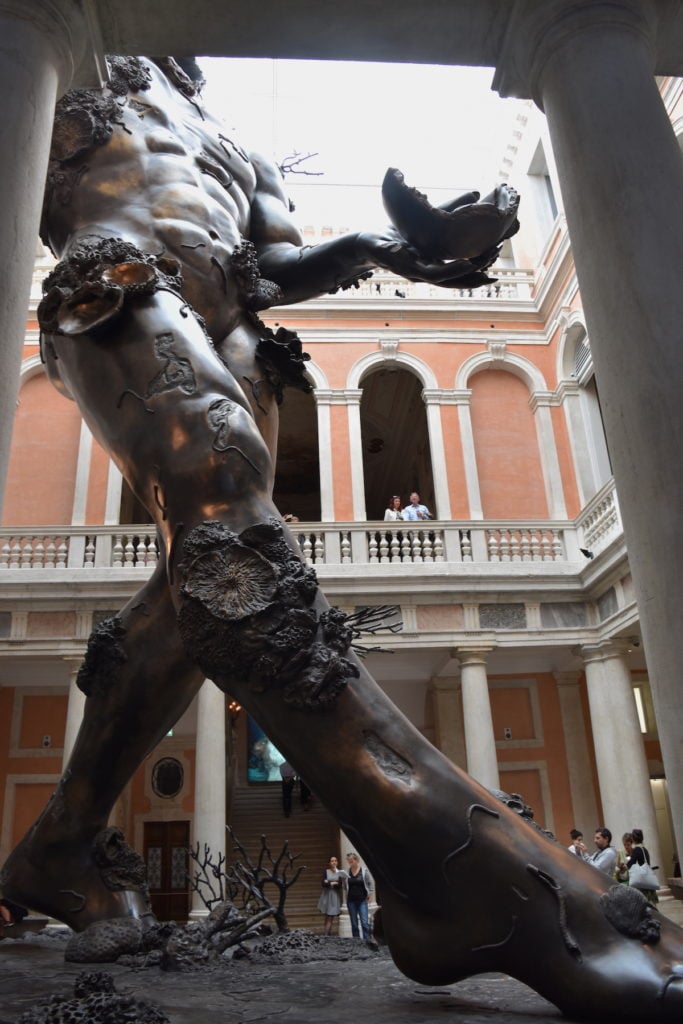
Colossus at the entrance of Damien Hirst’s “Treasures From the Wreck of The Unbelievable.” Image courtesy Ben Davis.
Taking over two museum-sized spaces, it was certainly blockbuster entertainment-level in terms of its scale, including immense colossi and delightfully goony monsters, all of it fabricated in state-of-the-art ways for maximum spectacular impact. But at its heart, Hirst’s big show reflected a realization about what it takes to keep step with the present: pure spectacle and deluxe materials, on the order of previous glittering outages like his diamond-studded skull, For the Love of God (2007), were no longer enough for this particular decade. Now, the art has to open a new front of universe-building.
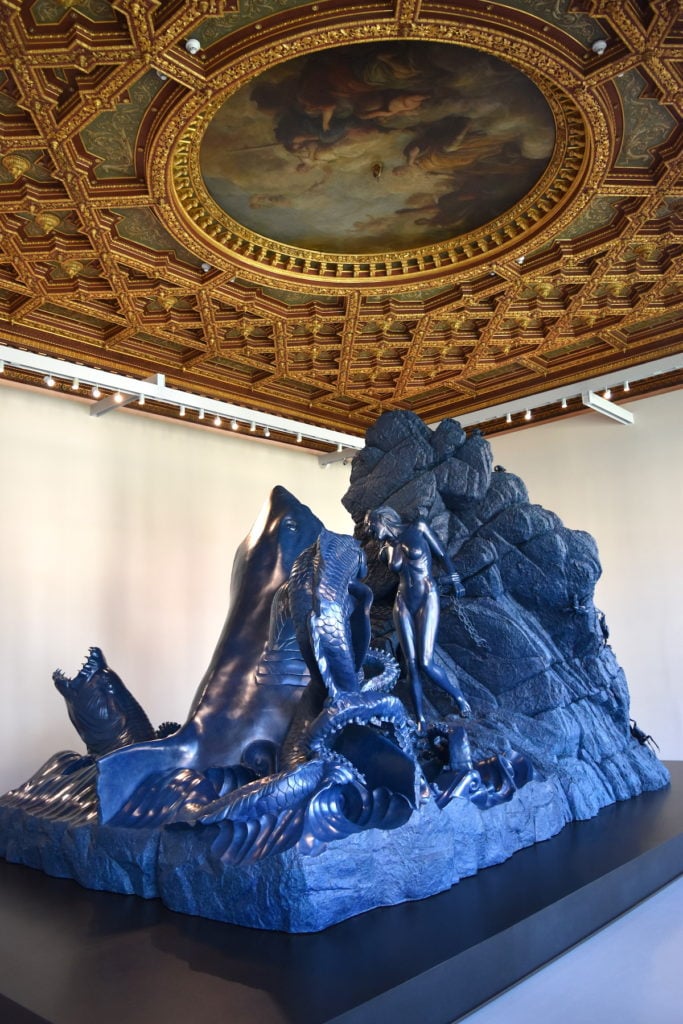
Installation view of sculpture in “Treasures from the Wreck of The Unbelievable.” Image courtesy Ben Davis.
Does “Treasures” draw on pop myth? Yes. The whole thing is framed as a riff on the National Geographic fascination with lost treasures and underwater expeditions. It created its own free-standing, fantastical version of these, presenting its show as the salvaged cargo of the downed ship The Unbelievable, sunk with a hold full of world treasures from an ancient collector, Cif Amoten II. Hirst would even release a Netflix special about discovering the treasure, as if the whole thing were real.
Is it self-referencing and mutually reinforcing? Yes. Every individual sculpture is both its own discrete object, and a reference point in the larger “Unbelievable” story. Videos onsite showed various sculptural trophies being dredged from the sea floor. The most striking part was a scale model of the (fake) sunken ship, with a touchscreen viewfinder that you could scan over the diorama to view where each of the individual treasures was supposedly found within the shipwreck, calling up information about them—a gee-whiz, better-than-perfect rendering of an educational museum attraction about the Wreck of The Unbelievable.

Model of The Unbelievable in “Treasures from the Wreck of The Unbelievable.” Image courtesy Ben Davis.
Is it full of Easter eggs? Well, yes. The entire mythical framework of the show allowed for a mix-and-match aesthetic of sculptures channeling various mythologies, along with “ancient” artifacts that foretold the forms of Mickey Mouse or Optimus Prime. Busts riffed on singers YoLandi Visser, Rihanna, or Pharrell, or on Hirst himself. The entire thing is meant to sustain the interest of code-breakers digging for the treasure of these referential nuggets.
The weirdnesses and missteps of the show were explicable by the common perils of that level of blockbuster as well. Just as the need for merchandisable product or possible sequels introduces awkward elements into blockbuster films, so “Treasures From the Wreck of the Unbelievable” was plagued by strange redundancy: multiple, cloned versions of each sculpture. These were presented as restored versions for museum display versus the original coral-clad versions ripped from the sea floor, though sometimes the “restored” forms oddly also had coral forms recreated on them in bronze. The effect was like a glitch that upset the narrative logic of the show, and the underlying justification seemed to be just having more product to move.
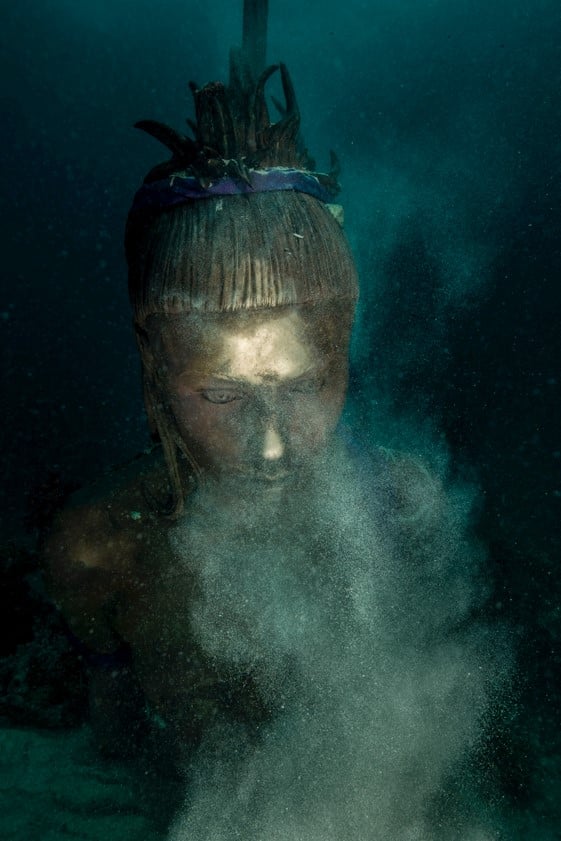
Image from Damien Hirst’s “Treasures from the Wreck of the Unbeliebavable.” Photo Christoph Gerigk, ©Damien Hirst and Science Ltd.
Similarly, there were moments of strange sadism and pornographic excess in Hirst’s “Treasures.” The one that sticks in my memory is an ultra-graphic sculpture of a minotaur pinning and raping a screaming nymph. I interpret these moments as similar to the over-the-top viciousness and titillation of certain notorious moments in Game of Thrones, or the unearned portentousness and gratuitous nastiness of Zack Snyder’s joyless Batman v. Superman (infamously, the director said that he wanted to conjure an atmosphere where viewers believed that Batman could, “like, get raped in prison”). They serve a purpose: Basically, the excess seems to be motivated by the need to slap the audience into taking the whole thing Very Seriously, to forget, for a moment, that they are investing energy in something so silly as dragons or super-men or, in this case, a fundamentally meaningless mythology about an underwater treasure.
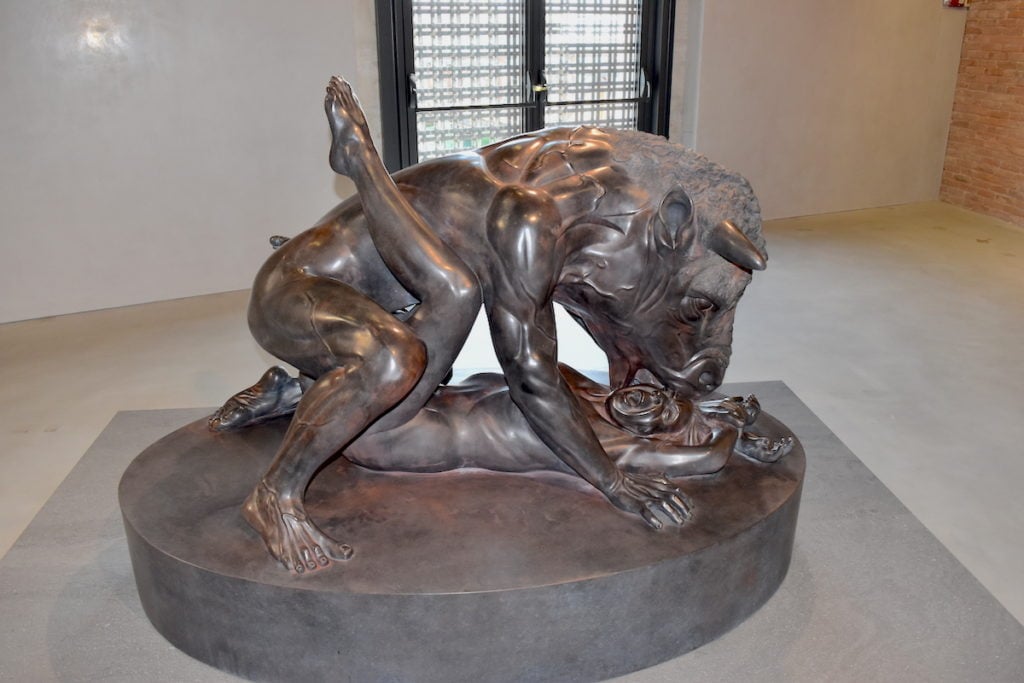
Installation view of minotaur sculpture in “Treasures from the Wreck of The Unbelievable.” Image courtesy Ben Davis.
In any case, Hirst’s show represents culture playing at the level where it warrants those comparisons, and that criticism. But since the erstwhile Young British Artist has always been about grand guignol show-stopper art in the first place, is there a more indie role model? Is there a way to approach the “universe-building art” format that isn’t the equivalent of fan graphics on DeviantArt?
The example that comes to mind as a rough analogue is from Jill Magid, specifically in the project that has occupied her over the last few years, “The Barragán Archives.” Magid first came onto the scene creating works about surveillance, taking interviews with Dutch secret service agents and spinning their confessions into installation art, and, ultimately, fan fiction.
More recently, she has devoted herself to a series of works about the Mexican modernist architect Luis Barragán (1902-1988), something of a national hero in his native country whose archive is—unexpectedly—controlled by the collector Federica Zanco in Switzerland, who according to an (unsubstantiated) rumor received the trove in lieu of an engagement ring from her husband, and who is unwilling to provide scholars access.
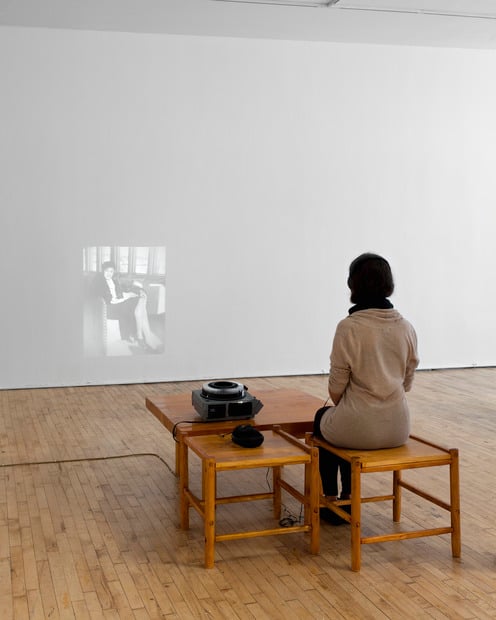
Jill Magid, Dearest Federica (2013). Image courtesy the artist and Art in General. Photography by Steven Probert.
Since the real Barragán Archives were inaccessible under the tight stewardship of Zanco, Magid’s work became about finding ways to represent his legacy in absence of the concrete access. Thus, in the series’s 2013 incarnation at Art in General, she used love letters from the architect to build what amounted to a kind of amorous fan fiction around his legend, which then touched off a correspondence with Zanco, which inspired and bled into the next phase of the project, and so on. As the official site explains, “[e]xhibitions of the project exist as opportunities to push the narrative forward,” that is, as links in the expanded chain.
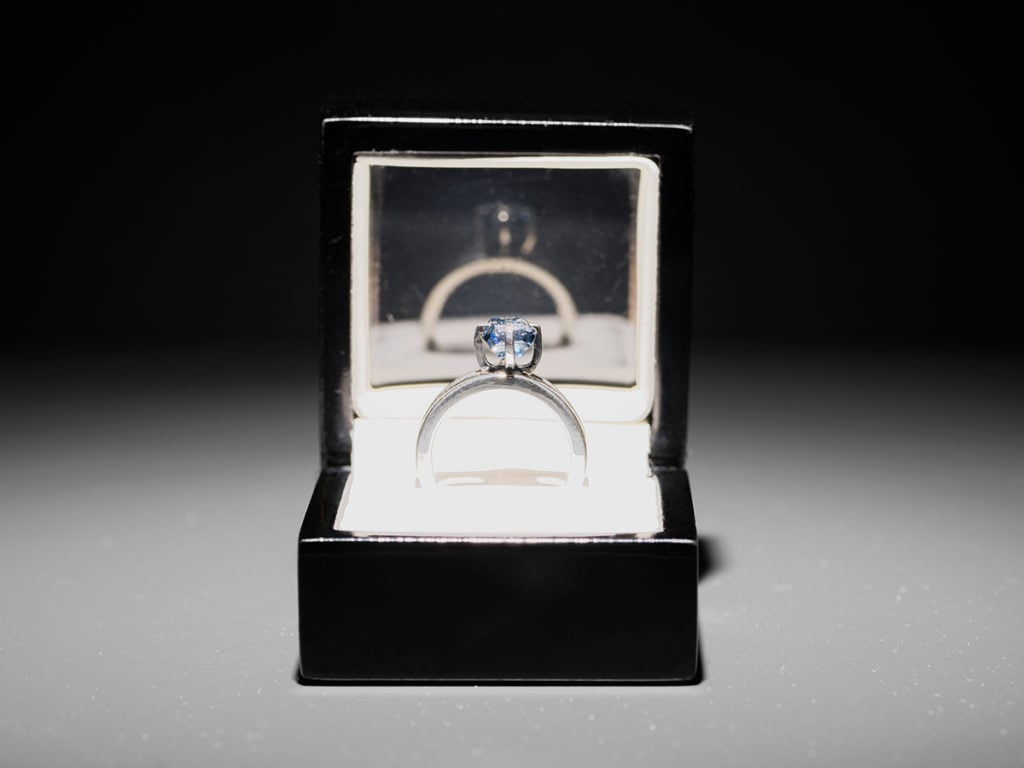
Image from Jill Magid: The Proposal, bluae diamond ring with inscription, “I am wholeheartedly yours.”Courtesy of the artist; LABOR, Mexico City; RaebervonStenglin, Zurich and Galerie Untilthen, Paris.
The whole thing more or less concluded last year with the stunt of Magid getting permission from the Barragán estate to have part of his remains exhumed and transformed into a diamond, which she then set in an engagement ring that she used to “propose” to Federica Zanco, in an effort to get her to repatriate the archives to Mexico. (It was unsuccessful.) This in turn spun off a film, The Proposal, currently in the Tribeca Film Festival.

Press image for Jill Magid’s The Proposal.
Now, the legend of Barragán is much more nerdy and niche than, say, Spiderman or even Hirst’s fictional Cif Amoten II. But because the whole project was specifically about how intellectual property functions—unique “IP” being the building blocks for Expanded Universes of all kinds—“The Barragán Archives” initiative can be seen as an extended riff on how a mere non-superpowered mortal might hack their way into the contemporary expanded-media game.
But here’s an important point: This kind of operation doesn’t exactly guarantee that something is any good. Will The Avengers: Infinity War pull off its woolly balancing act? Hirst’s Treasures From the Wreck of the Unbelievable doc on Netflix is super-dull!
The whole expanded, multimodal interpenetration of media is a factor in the contemporary circulation of attention, but artistically the old-fashioned discrete object or experience matters: the isolated links in the chain still have to be entertaining and well-executed on their own. I suppose the grid of references something taps into can form a kind of safety net, in the sense that it keeps a given work from falling below a certain threshold of interest—and it is very, very hard to maintain a public’s interest now. But it also adds weight that can drag a project down.
Plugging into this condition is, at best, something like one the magical gems one might need to conquer the world. But conquering the world is definitely the scale at which media functions right now.